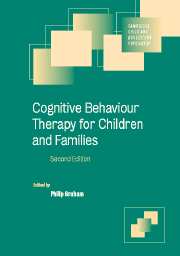Book contents
- Frontmatter
- Contents
- List of contributors
- 1 Introduction
- Part I Developmental cognitive theory and clinical practice
- Part II Engagement and assessment
- Part III Client groups
- Part IV Applications in psychosocial adversity
- 10 Cognitive behavioural treatment of the emotional and behavioural consequences of sexual abuse
- 11 Adjustment to parental separation and divorce
- Part V Applications in specific child and adolescent psychiatric disorders
- Part VI CBT applications in preventive interventions
- Index
- References
10 - Cognitive behavioural treatment of the emotional and behavioural consequences of sexual abuse
Published online by Cambridge University Press: 21 August 2009
- Frontmatter
- Contents
- List of contributors
- 1 Introduction
- Part I Developmental cognitive theory and clinical practice
- Part II Engagement and assessment
- Part III Client groups
- Part IV Applications in psychosocial adversity
- 10 Cognitive behavioural treatment of the emotional and behavioural consequences of sexual abuse
- 11 Adjustment to parental separation and divorce
- Part V Applications in specific child and adolescent psychiatric disorders
- Part VI CBT applications in preventive interventions
- Index
- References
Summary
Child sexual abuse has been defined as ‘the involvement of dependent, developmentally immature children and adolescents in sexual activities that they do not fully comprehend, are unable to give their informed consent to and that violate the social taboos of family roles’ (Schechter and Roberge, 1976). Recent research across a number of different countries has shown a consistently high prevalence of child sexual abuse. For example, using a random sample of adult women in San Francisco, Russell (1983) showed that 12% of women recalled at least one experience of extrafamilial abuse before the age of 14 with 28% recalling either intrafamilial or extrafamilial sexual abuse before the age of 14. Twenty-eight per cent recalled either intrafamilial or extrafamilial sexual abuse before that age. A survey from the UK found that 12% of females and 8% of males reported that they had been sexually abused before the age of 16 (Baker and Duncan, 1985), while an Australian study of almost 1000 tertiary students found that 13% recalled sexual experiences with an adult before the age of 12 (Goldman and Goldman, 1986). In a New Zealand investigation of 3000 women, Anderson et al. (1993) found that nearly one woman in three reported having one or more unwanted sexual experiences before the age of 16. Although methodological problems and inconsistencies are acknowledged with these studies, it is clear that child sexual abuse has a high prevalence.
Child sexual abuse can have a devastating impact on the development of the child.
- Type
- Chapter
- Information
- Cognitive Behaviour Therapy for Children and Families , pp. 157 - 169Publisher: Cambridge University PressPrint publication year: 2004



